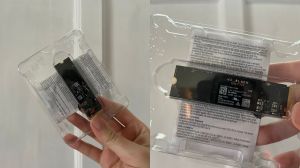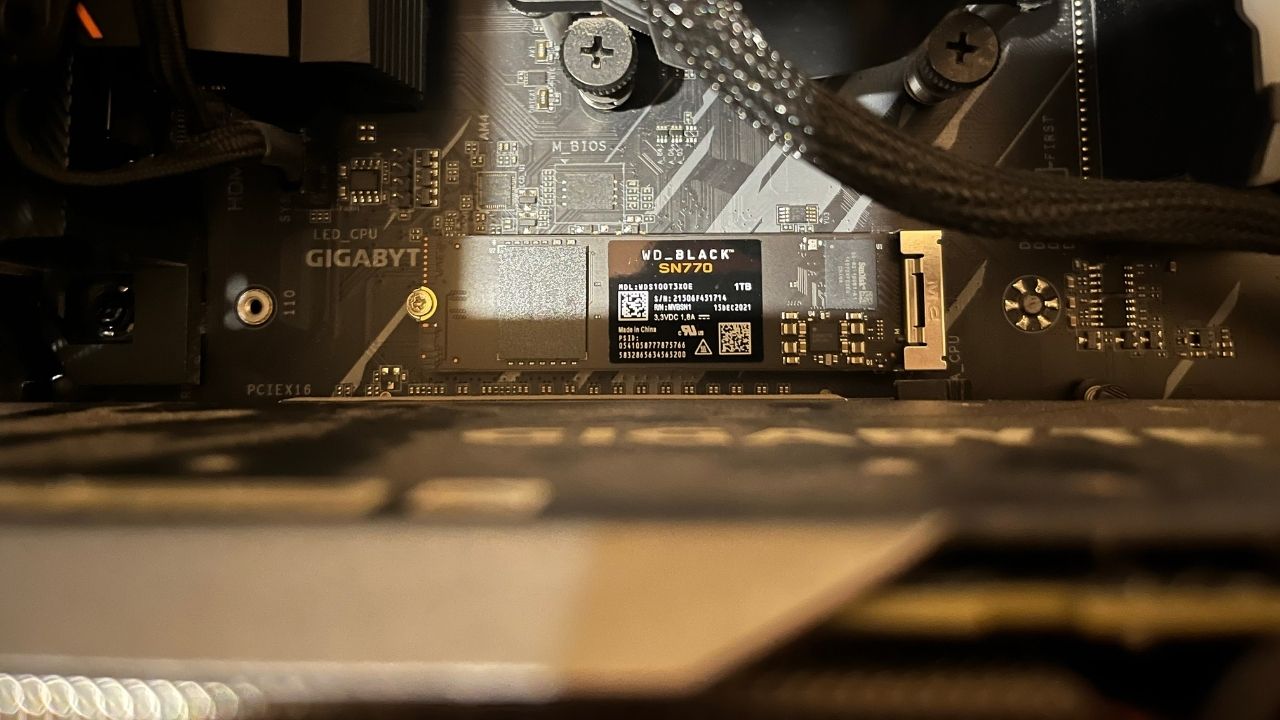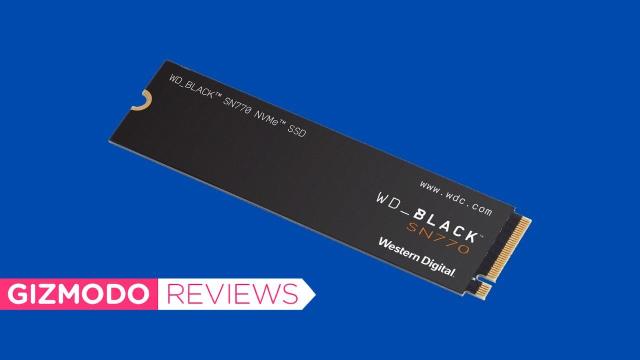The Western Digital Black SN770 is the first NVMe SSD I’ve had a play around with, and I’m very impressed.
I’ve long been curious about what an NVMe SSD could offer over a standard SATA SSD (mostly influenced by the cost). I could end this review in just a few lines by praising its speed, but I’d like to entertain the idea of the NVMe concept for a few lines. Let’s get into it.

The Western Digital Black SN770
What is it?
Western Digital's top of the line NVMe SSD
Price
$85 for 250GB, $145 for 500GB, $199 for 1TB and $449 for 2TB.
No like
Higher price than standard SSDs, speed difference isn't noticeable in every game, limited places to slot on most modern motherboards.
Okay, yeah, it’s fast
I’m going to be saying this a lot in this review. Never before had I truly tested NVMe hardware and now I know… And now I have a need for speed.
When I first performed speed tests, comparing the SN770 against the Western Digital Blue WDS100T2B0A SSD (a budget SSD from the same company) and a 2TB Seagate Barracuda ST2000DM001 HDD (a 10-year-old HDD from my original PC build) I didn’t see what was so special.
At first I was underwhelmed by the graphs that ATTO formed in testing my hard drive speeds: I assumed that each line was working off the same metric in the bottom of the graph… And then I checked again.

My god, 4.6GB/s write and 4.8GB/s read speed? That’s sooo unbelievably fast to a guy who was once left jaw-dropped at the speed difference between the HDD and the SSD.
But this is a testing application and the Western Digital Black series is aimed at gamers. How do these stats translate to gaming?
Well, I got a good idea with a handful of games: Assassin’s Creed Valhalla, Forza Horizon 5, Resident Evil 2, Stellaris and Watch_Dogs 2.
Superfast gaming? Kinda
We’ll start with Stellaris, because this was fairly amazing. In speed-testing the game, from clicking the icon to getting to the main menu, the SN700 hard drive really showed off.
While the standard SSD clocked a speed of 52 seconds from application start to main menu (the game frontloads a lot of its processes), the NVMe compressed this to a whopping 13 seconds.
I saw similar results in Resident Evil 2. From the main menu to gameplay on my save game, the SSD clocked in at 5 seconds. The NVMe clocked in at a sharp 3 seconds.
Finally, in Watch_Dogs 2, I saw probably the most impressive results. While the SSD took 1 minute and 16 seconds to go from main menu to gameplay, the NVMe only took 20 seconds.
Forza Horizon 5 and Assassin’s Creed Valhalla were unfortunate games to test with this, but I’ll mention them anyway because I have a point. In doing similar tests with both games, timing from the main menu to in-game content, I didn’t actually notice an observable difference. On both the SSD and the NVMe, the speeds were basically identical.
And, look, the reason for this is probably obvious for some people reading the review, but if it’s not, I’ll spell it out.
Forza Horizon 5 and Assassin’s Creed Valhalla have a lot of spinning plates going on in the background during load times. Forza Horizon 5 is an always-online game that has a minimum amount of time required to get everything in order before it lets you in the game. Assassin’s Creed Valhalla is similar. The speed test on both drives clocked in at about 22 seconds, though Valhalla isn’t an always-online game. I tried a few times after a few reboots, but the results kept being replicated.
What I’m getting at is: the background processes of games are often very different from each other, for which the Western Digital SN770 NVMe can’t compensate. It’s a long-winded way of saying that these games aren’t made for a drive this fast.
Sure, games that have streamlined loading systems that don’t have a bunch of other stuff going on behind the scenes (like complex online and multiplayer content) will load faster, but you won’t notice the speed boost of NVMe in every aspect of every game. I definitely, however, noticed speed differences in the initialisation phase of most applications (as in, when you first click open from Windows). Things definitely moved a lot faster at this point.

Slick stick
I was caught off guard by how small the NVMe is. I always thought that they were long and quite large, but the Western Digital SN770 NVMe is nothing of the sort. Its size is comparable to a small, thin wafer. A super-thin wafer, at that.
Perhaps it’s because of NVMe casings that I was surprised. See, there are some NVMe SSDs that come with a heatsink (a casing on the outside that allows for handling heat better) and there is a market for aftermarket or complimentary heatsinks.
Heat can absolutely damage your NVMe, but if you’ve got good airflow and a motherboard with a heatsink, you should be alright. The NVMe I was sent didn’t come with a heatsink, so I didn’t mind. My computer has fairly good thermal control anyway.
I’d love to imagine the humble NVMe will be mostly used in Mini PC builds before becoming a widely-used standard in larger PCs. It’s already used in the PS5 and the Xbox Series X|S as the internal hard drive, but its size and hardware is very favourable: no need for big cables and it attaches directly to the motherboard. Terrific.
Is it time to NVMe?
While I don’t think the NVMe is necessary for PC gaming, I definitely think it’s a treat. Its speed is unparalleled by SSDs, and obviously by HDDs, and the price is at a point now where you can effectively treat yourself without breaking the bank.
I think Western Digital has created a fine piece of tech with the SN770 NVMe: it’s the first time that I’ve seriously considered an NVMe upgrade for my gaming rig and, now that I’ve gone hands-on with one, I’m very excited for it to become the standard.
I just hope that cheaper motherboards start to pack multiple NVMe ports at some point. I could load four SSDs on my motherboard, but only one NVMe.
Where to buy the Western Digital Black SN770 NVMe
Below are links to 1TB SN770 NVMe SSDs, however other options are available.
Amazon Australia ($172) | Mwave ($199) | Scorptec ($199) | Umart ($258)
